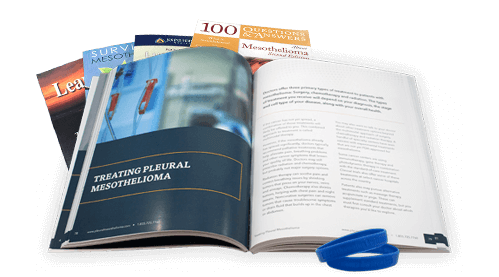Pericardial Mesothelioma
Pericardial mesothelioma is a rare, asbestos-related cancer that develops in the heart lining, known as the pericardium. Symptoms include chest pain, irregular heartbeat and shortness of breath. Average survival is six months, but surgery and chemotherapy help some patients live for years.
What Is Pericardial Mesothelioma?
Pericardial mesothelioma is an extremely rare cancer that develops in the pericardium, which is a protective layer of tissue that lines the heart. The pericardium is the medical term for the mesothelium that lines the heart.
Pericardial mesothelioma makes up less than 1% of all cases of mesothelioma cancer, which may develop in three other locations, including the linings of the lungs, abdomen or testes. According to a 2017 review published in Annals of Epidemiology, 251 cases of pericardial mesothelioma have been reported in medical literature. It accounts for 4% of cancers that develop in the heart and pericardial lining.
A 2020 analytical study of the Italian National Mesothelioma Registry was the first to confirm a causal relationship between pericardial mesothelioma and occupational asbestos exposure. A 2010 Italian study published in Occupational and Environmental Medicine reported a history of asbestos exposure in approximately 62% of pericardial mesothelioma cases.
Reports on survival range from as short as two months to more than six years. Chemotherapy and surgery help patients live several months or years longer than they would without treatment. Radiation therapy is sometimes used when combined with surgery, and some patients have responded well to immunotherapy.
Pericardial Mesothelioma Symptoms
Pericardial mesothelioma is like other types of mesothelioma cancer in that the initial symptoms appear mild and indicative of other conditions. Chest pain, heart palpitations, difficulty breathing and fluid buildup are the most common early symptoms.
Most symptoms of mesothelioma develop slowly and seem innocuous or manageable at first, which often delays diagnosis until more serious symptoms signal the need for comprehensive testing.
- Chest pain
- Heart palpitations or irregular heartbeat
- Murmurs
- Fluid buildup around the heart
- Difficulty breathing
- Shortness of breath when lying flat
- Cough
- Fatigue
- Fever
- Night sweats
As the condition progresses, patients may develop anemia, loss of appetite, weight loss, nerve pain and heart failure.
Treatment is available to help patients overcome or cope with symptoms. Medication, procedures and anti-cancer therapies help control symptoms and cancer growth.

Diagnosing Pericardial Mesothelioma
Pericardial mesothelioma remains a difficult cancer to diagnose because symptoms resemble other conditions and diagnostic imaging of the heart lining often fails to identify tumors. Non-specific symptoms make diagnosing mesothelioma of other types difficult as well.
The most common imaging tool used to locate pericardial tumors is a two-dimensional echocardiography. If a patient has pericardial effusion, or fluid buildup in the heart lining, it can make it difficult to visualize tumors. Additionally, lung gases may interfere with imaging results and make it hard to locate tumors.
A pericardiocentesis to drain fluid from the heart lining may result in a diagnosis, but many fluid samples don’t contain cancerous cells. An open pericardial biopsy is used to collect a tissue sample for an official diagnosis. This uses imagery to guide a needle into the heart lining for tissue collection. Some patients don’t receive an official diagnosis until they undergo aggressive surgery.
Because of its rarity, no official staging system exists for pericardial mesothelioma.
Misdiagnosis
Patients are commonly misdiagnosed with other conditions. Only 20% of patients receive a diagnosis before they die of the disease.
Many patients are misdiagnosed with acute pericarditis, cardiomyopathy, coronary heart disease or systemic lupus erythematosus.
Causes and Risk Factors of Pericardial Mesothelioma
In 2020, an Italian analytical study was the first to conclusively find a causal relationship between asbestos and pericardial mesothelioma.
Prior to this study, which was published in Scandinavian Journal of Work, Environment and Health, limited evidence connected cases of pericardial mesothelioma to asbestos exposure. The cancer’s low incidence rate and the decades-long latency period of mesothelioma made it challenging to gather enough data to show a relationship.
Other potential risk factors reported in medical literature include simian virus 40 infection, tuberculosis, genetic predisposition and history of radiation therapy. Asbestos exposure remains the primary proven cause of mesothelioma.
Pericardial Mesothelioma Prognosis
The prognosis for pericardial mesothelioma, which defines the overall outlook for patients, is poor because there is no cure for malignant mesothelioma. Life expectancy refers to how long patients live with the disease, and survival rate is based on data of how long people lived with the disease in the recent past.
The typical life expectancy following diagnosis is between six and 18 months, but some patients have a median survival around two months. One case report described a patient in her 20s who survived more than six years after undergoing chemotherapy and immunotherapy.
According to a 2021 review published in Seminars in Thoracic and Cardiovascular Surgery, the overall 1- and 2-year survival rates for pericardial mesothelioma were 22% and 12.2% respectively.

Pericardial Mesothelioma Treatment
The most effective mesothelioma treatment options for pericardial mesothelioma involve multimodal treatment with surgery, chemotherapy and sometimes radiation therapy. A limited number of patients are diagnosed early enough to qualify for this aggressive treatment approach. Most patients undergo chemotherapy, and some try experimental therapies when chemotherapy stops working.
Experimental second-line treatment for pericardial mesothelioma has included immunotherapy with pembrolizumab, which is marketed under the brand name Keytruda.
Treatment options resemble those offered to patients with other forms of the cancer, including pleural mesothelioma and peritoneal mesothelioma, which also respond best to multimodal treatment.
Surgery
The two aggressive surgeries used to treat this rare cancer are pericardiectomy and tumor resection surgery. A pericardiectomy removes all or part of the pericardial lining. Tumor resection surgery removes tumors on the pericardial lining rather than removing the lining itself. A 2019 review published in Clinical Lung Cancer found better outcomes with tumor resection compared to pericardiectomy.
A minimally invasive surgical procedure called pericardiocentesis is used to drain fluid buildup within the heart lining.
Chemotherapy
Patients diagnosed too late to qualify for surgery are often eligible for chemotherapy, which may alleviate symptoms and add months to life expectancy. Some patients respond well to chemotherapy and live for years after treatment. For example, one young patient in her mid-20s lived 4.5 years by undergoing chemotherapy followed by immunotherapy with Keytruda.
The most common chemotherapy drugs for pericardial mesothelioma include cisplatin, pemetrexed (Alimta) and gemcitabine (Gemzar).
Radiation Treatment
Radiation therapy is rarely used to treat pericardial mesothelioma because the risk of damaging the heart is high. When it has been used, it was part of multimodal treatment that included surgery and chemotherapy.
Palliative Care
Palliative care refers to therapies that aim to improve symptoms and quality of life. For pericardial mesothelioma, this type of care may involve medications, procedures and therapies to relieve pain and pressure around the heart.
For example, pain medication helps patients cope with pain caused by tumors pressing against the heart and lungs. Chemotherapy and pericardiocentesis may be used palliatively to control symptoms, including pain and fluid buildup around the heart.


